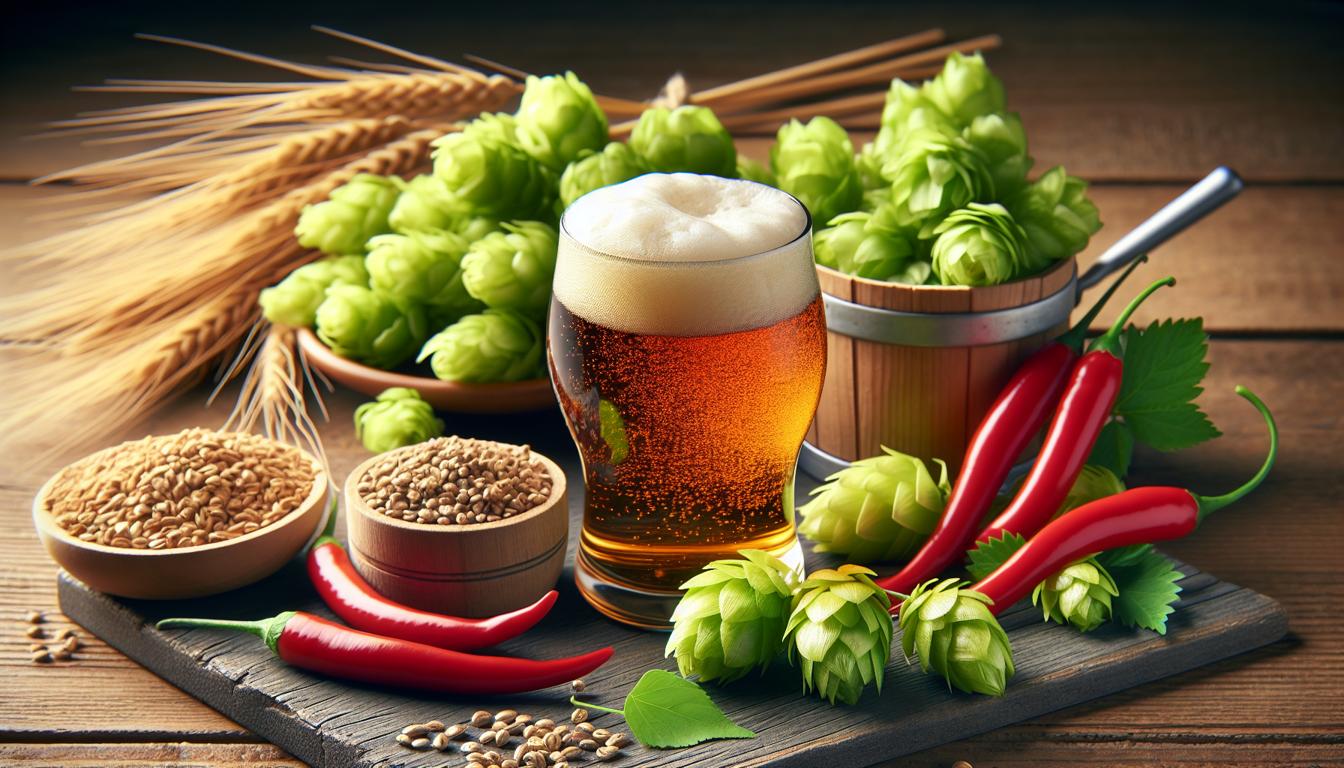Chili beer is a unique and exciting beer style that combines the flavors of a traditional beer with the heat and complexity of chili peppers.
Originating in Mexico, this style has gained popularity around the world for its bold and spicy character. In this recipe post, I will guide you through the process of brewing your own chili beer, sharing my personal anecdotes and expert advice along the way.
The History of Chili Beer
Chili beer has its roots in Mexican cuisine, where the combination of chili peppers and beer is a common tradition. The first recorded instance of chili beer dates back to the 16th century, when the Aztecs brewed a beverage called “chilate” by fermenting corn, chili peppers, and water.

This early version of chili beer was known for its fiery kick and was often consumed during religious ceremonies.
Over the years, chili beer evolved and became more refined. In the 20th century, commercial breweries started experimenting with adding chili peppers to their beers, creating a new style that quickly gained popularity. Today, chili beer is enjoyed by beer enthusiasts worldwide, with variations that range from mild and approachable to incredibly spicy and intense.
Key Characteristics of Chili Beer
Chili beer is characterized by its unique combination of flavors and aromas. The heat from the chili peppers adds a spicy kick that can range from subtle warmth to intense fire, depending on the variety and quantity of peppers used.
The heat is balanced by the malt sweetness and hop bitterness of the beer, creating a complex and harmonious flavor profile.
Chili beers can vary in color and style, with some brewers opting for light and refreshing lagers, while others prefer the rich and malty flavors of a stout or porter. The choice of chili peppers also plays a significant role in the final flavor of the beer. Different varieties, such as jalapeños, habaneros, or even ghost peppers, can impart distinct levels of heat and unique flavor characteristics.
Brewing a Chili Beer
Now that we have explored the history and characteristics of chili beer, it’s time to dive into the brewing process. Brewing a chili beer requires careful consideration of ingredients, techniques, and timing to achieve the perfect balance of heat and flavor. Let’s get started!
Ingredients
To brew a chili beer, you will need the following ingredients:
– Base Beer: Choose a beer style that will complement the flavors of the chili peppers. Lighter styles, such as a blonde ale or a wheat beer, work well for milder chili beers, while darker and more robust styles, like a stout or a porter, can handle the intensity of spicier peppers.
– Chili Peppers: Select the chili peppers that match your desired level of heat and flavor. Popular choices include jalapeños, serranos, habaneros, and even hotter varieties like ghost peppers. It’s important to note that the heat level of peppers can vary, so consider doing a small taste test before adding them to your beer.
– Malt: Choose a combination of malts that will provide a solid base for your chili beer. For lighter styles, use pale malts or a blend of pale and wheat malts. For darker styles, incorporate roasted malts like chocolate or black malt to add depth and complexity.
– Hops: Select hops that will balance the sweetness of the malt and the heat of the chili peppers. Bittering hops like Magnum or Chinook work well in this style, but feel free to experiment with different hop varieties to achieve your desired flavor profile.
– Yeast: Choose a yeast strain that complements the flavors of your base beer style. For clean and neutral flavors, a American Ale yeast strain is a good choice. If you want to add some fruity esters to your beer, consider using a Belgian or English Ale yeast.
Brewing Process
Now that we have gathered our ingredients, let’s walk through the brewing process step by step.
1. Mashing: Begin by mashing your grains in hot water to extract the sugars needed for fermentation. Follow the instructions for your specific malt blend, aiming for a target mash temperature that will promote the desired level of body and sweetness in your beer.
2. Boiling: Once the mash is complete, transfer the liquid (known as wort) to a large pot and bring it to a boil. This is the perfect time to add your bittering hops to balance the sweetness of the malt. Follow your recipe or hop schedule for specific timing and quantities.
3. Adding Chili Peppers: While your wort is boiling, prepare your chili peppers by removing the stems and seeds. The seeds and membranes of the peppers contain most of the capsaicin, the compound responsible for the heat. If you prefer a milder chili beer, remove the seeds and membranes before adding the peppers to the boil. For a spicier beer, leave them intact or even add some extra seeds.
4. Sanitizing: Before adding the chili peppers to the boil, it’s important to sanitize them to prevent any unwanted bacteria or wild yeast from contaminating your beer. You can sanitize the peppers by soaking them in a solution of sanitizing agent, such as Star San, for a few minutes.
5. Adding Chili Peppers to Boil: Once your peppers are sanitized, carefully add them to the boiling wort. The heat of the boil will help extract the flavors and heat from the peppers. Remember, the longer you boil the peppers, the more heat and flavor they will contribute to the beer. Keep in mind that the heat can intensify during fermentation, so be cautious not to overdo it.
6. Cooling and Fermentation: After the boil, cool the wort to the appropriate temperature for fermentation and transfer it to a sanitized fermenter. Pitch your selected yeast strain and seal the fermenter with an airlock. Ferment your chili beer according to the yeast’s recommended temperature range, making sure to maintain a stable fermentation environment.
7. Secondary Fermentation: After primary fermentation is complete, you have the option to transfer your beer to a secondary fermenter for further clarification and flavor development. This step is not necessary but can help improve the overall quality of your chili beer.
8. Bottling or Kegging: Once your beer has reached its desired flavor and clarity, it’s time to package it. Whether you choose to bottle or keg your chili beer, make sure to properly clean and sanitize all equipment to prevent any contamination. Carbonate your beer to the appropriate level, and enjoy the fruits of your labor!
Conclusion
Brewing a chili beer is a thrilling and rewarding experience that allows you to explore the unique flavors and aromas of chili peppers in a traditional beer style. By carefully selecting your ingredients, following the brewing process, and paying attention to timing and balance, you can create a chili beer that is truly exceptional.
Remember to start with milder peppers if you are new to brewing chili beer, gradually increasing the heat level as you become more comfortable with the process. Additionally, keep in mind that the heat of the chili peppers can intensify during fermentation, so be cautious not to overdo it.
So, gather your ingredients, fire up your brew kettle, and embark on the journey of brewing your own chili beer. Cheers to the perfect balance of heat, flavor, and craftsmanship!
FAQs
When should I add beer to my chili?
Beer can be added to chili at various stages of the cooking process, depending on the desired flavor profile. If you want a subtle hint of beer, add it towards the end of cooking. For a more pronounced beer flavor, add it earlier in the cooking process and allow it to simmer with the other ingredients. Ultimately, the timing of adding beer to chili is a matter of personal preference.
Why does beer make chili taste better?
Beer can enhance the flavor of chili due to its unique characteristics. The hops and malt in beer add depth and complexity to the dish, while the carbonation helps tenderize the meat. The alcohol in beer also acts as a flavor carrier, helping to distribute the flavors of the spices and ingredients throughout the chili.
What kind of beer is best for chili?
When it comes to choosing a beer for chili, a malty and flavorful beer like a brown ale, amber ale, or stout works best. These styles complement the rich and hearty flavors of the chili and add depth to the dish. Avoid hop-forward beers as they can overpower the flavors of the chili.
What is the best beer to cook with?
The best beer to cook with depends on the dish you are preparing. However, generally, a lager or a pale ale with a balanced flavor profile works well in many recipes as it adds depth and richness without overpowering the dish.
How to make Paula Deen chili?
To make Paula Deen chili, you will need ground beef, onion, bell pepper, garlic, chili powder, cumin, salt, diced tomatoes, tomato sauce, kidney beans, and optional toppings like cheese and sour cream. Start by browning the ground beef with onions, peppers, and garlic. Drain any excess fat. Add the chili powder, cumin, and salt, and cook for a few minutes. Stir in the diced tomatoes, tomato sauce, and kidney beans. Simmer for at least 30 minutes to allow the flavors to meld together. Serve hot with desired toppings.
Can you substitute beer for water in chili?
While beer can add flavor to chili, it cannot be substituted for water entirely. Water is necessary to create the base of the chili and to help cook the ingredients properly. Beer can be used in combination with water or broth to enhance the taste and add depth to the chili, but it should not be used as a complete replacement for water.





Leave a Reply
You must be logged in to post a comment.